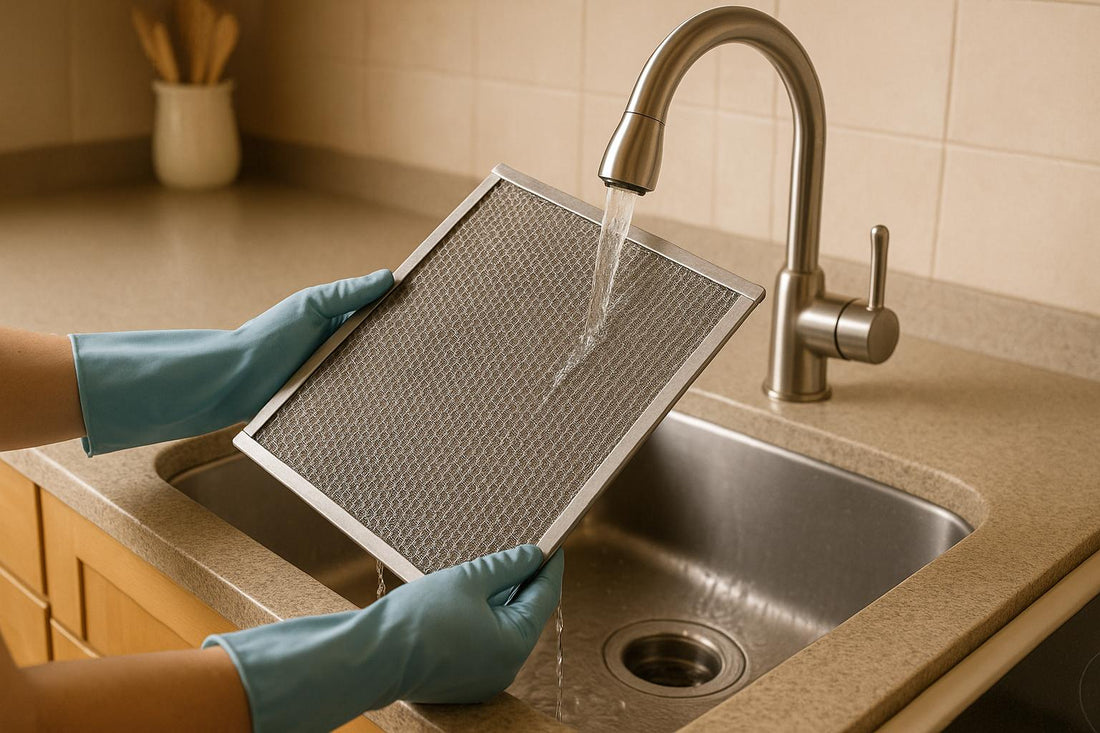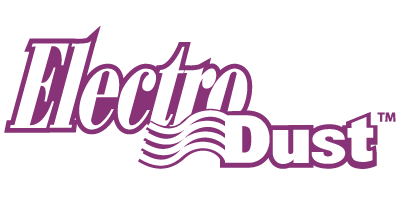
How to Clean a Reusable Furnace Filter: Step-by-Step Guide
Share
Reusable furnace filters can save you money and reduce waste, but they need proper cleaning to work effectively. Here's a quick summary of how to clean yours:
- Turn off your furnace. Let it cool for 20 minutes to avoid unfiltered air circulation.
- Remove the filter. Carefully slide it out, noting the airflow direction for reinstallation.
- Vacuum loose debris. Use a vacuum with a brush attachment to clean both sides.
- Wash with soap and water. Use mild dish soap, lukewarm water, and a soft brush to scrub gently.
- Rinse thoroughly. Ensure all soap is removed and shake off excess water.
- Air dry completely. Place the filter on a drying rack or towels for several hours to prevent mold.
Clean every 1–3 months depending on dust levels in your home. Avoid harsh chemicals, dishwashers, or pressure washers to prevent damage. Regular maintenance keeps your HVAC system efficient and extends the filter's lifespan, which can be up to 10+ years.
Tools and Materials You'll Need
Required Tools and Supplies
Cleaning a reusable furnace filter doesn’t demand anything fancy - just some basic items you likely already have at home. A little preparation goes a long way in keeping your filter in top shape.
- For initial cleaning: Use a vacuum with a brush attachment to gently remove loose dust.
- For washing: Gather a soft-bristled brush (an old toothbrush works great), mild dish soap, and lukewarm water. A sink or bathtub is ideal for this step.
- For drying: Have clean towels or a drying rack ready to ensure the filter air-dries completely.
- For minor clogs: A low-pressure vacuum hose can help clear both sides of the filter.
Once you’ve got everything set, you’re ready to move on to the cleaning process.
Why Use Mild Cleaning Products
When cleaning your filter, it’s essential to stick with mild cleaning products. Why? Reusable filters depend on their electrostatic properties to trap particles effectively, and harsh chemicals can compromise this delicate mechanism.
Avoid using bleach, ammonia-based cleaners, or anything with strong chemicals. These can damage the filter and reduce its efficiency. Instead, lukewarm water paired with gentle dish soap is your best bet. When rinsing, use a soft faucet spray to prevent any harm to the filter’s structure.
How to Wash an Electrostatic Furnace Filter
How to Clean Your Filter: Step-by-Step
With your tools ready, it’s time to roll up your sleeves. Follow these steps to clean your reusable furnace filter safely and effectively, keeping your HVAC system in top shape.
Step 1: Turn Off Your Furnace System
Start by switching off the furnace and any nearby fans at least 20 minutes before cleaning. This gives the system time to cool down and prevents unfiltered air from circulating.
Double-check the power is off by trying to turn on the furnace at the thermostat. If nothing happens, you’re good to go. To protect yourself from dust, consider wearing gloves and a mask. Open a window or use a fan to improve ventilation and reduce exposure to dust and debris.
Once everything is powered down and cooled, you can safely remove the filter.
Step 2: Remove the Filter
Locate the filter, typically near the furnace or air handler, and carefully slide it out of its housing. Pay attention to the airflow direction arrow marked on the filter - it’ll help you reinstall it correctly later. Be mindful not to touch any electrical components while removing it.
Step 3: Remove Loose Dirt and Debris
Start by vacuuming both sides of the filter using a brush attachment to remove loose dirt. If there’s stubborn debris, rinse the filter under running water, directing the flow opposite to the airflow direction. For tougher clogs, a low-pressure vacuum hose can help.
Step 4: Scrub with Soap and Brush
Prepare a basin of lukewarm, soapy water. Use a soft-bristled brush (or even an old toothbrush for tight spots) to scrub the filter gently in circular motions. Pay extra attention to dirtier areas, but don’t apply too much pressure, as this could damage the filter.
Make sure you clean both sides evenly for the best results.
Step 5: Rinse and Dry Completely
Rinse the filter thoroughly with lukewarm water to wash away all the soap. Shake it gently to remove excess water, then leave it to air dry completely for several hours. It’s crucial to ensure the filter is fully dry before reinstalling it - any leftover moisture could lead to mold growth or damage your HVAC system.
sbb-itb-adeab55
Tips for Long-Term Filter Care
Keeping your HVAC system running smoothly and extending the life of your filter requires consistent care. Here’s how you can maintain your filter over time.
How Often to Clean Your Filter
The sweet spot for cleaning your filter is every 1–3 months, depending on how much dust builds up in your home. Factors like having pets or family members with respiratory issues might mean checking it monthly instead of quarterly.
"A good rule of thumb is to check your reusable filter every 1–3 months, and if it looks dirty, it's time for a cleanup." - dolphincooling.com
A quick way to check? Hold the filter up to a light source. If the light struggles to pass through, it’s time for a cleaning. Even during times when your HVAC isn’t working hard, dust still collects. Cleaning it regularly prevents buildup that could affect performance. And remember, avoiding common cleaning mistakes will help your filter last longer.
Cleaning Mistakes to Avoid
- No Dishwashers or Pressure Washers: Don’t toss your filter in the dishwasher or blast it with a pressure washer. High heat, harsh detergents, and strong water pressure can warp the frame or damage the filtering material.
- Skip Harsh Chemicals: Steer clear of bleach, ammonia, or other strong cleaning agents, as they can weaken the filter material.
- Let It Dry Fully: Resist the urge to use a hair dryer or heater to speed up drying. A damp filter can invite mold and mildew. Always let it air dry completely before reinstalling.
- Be Gentle When Cleaning: While reusable filters are made to last, over-scrubbing can damage the material or bend the frame. Use a soft brush and gentle, circular motions.
Setting Up Cleaning Reminders
To stay consistent, schedule regular filter maintenance. Use your digital calendar or smart thermostat to set reminders every 1 month. Many smart thermostats even have built-in features that track system runtime and notify you when it’s time to clean.
You can also tie filter cleaning to other routines, like the start of a new season or when you pay your utility bills. Home maintenance apps can be helpful too, sending push notifications and offering tips specific to your HVAC system. A little planning goes a long way in keeping your filter - and your HVAC system - working efficiently.
Conclusion
Keeping your reusable furnace filter clean is both straightforward and worthwhile. By following a few simple steps - turning off your HVAC system, removing the filter, brushing off debris, washing it with mild soap, and ensuring it’s completely dry - you’re actively improving your home’s air quality while saving money.
Regular maintenance doesn’t just extend the life of your filter; it also brings tangible benefits. Cleaning your filter every 1 month can boost indoor air quality and improve your HVAC system’s efficiency, potentially cutting energy usage by up to 15%. This means lower utility bills and less strain on your furnace.
To stay on top of this routine, consider using tools like digital alerts, smartphone reminders, or even a wall calendar. These small habits ensure your furnace runs smoothly year-round.
The perks go beyond saving money. Routine cleaning helps avoid performance dips and costly repairs. Plus, a reusable filter that’s well cared for can last for years, making it a smart choice for both the environment and your budget.
Commit to maintaining your reusable filter for better efficiency, lower costs, and a healthier living space.
FAQs
What are the warning signs that my reusable furnace filter needs to be cleaned before the usual 1–3 month schedule?
If you’re experiencing weaker airflow, odd smells, or see dirt accumulating on your filter, it’s probably time to clean it. Other red flags include rising energy costs, inconsistent heating or cooling, your furnace cycling on and off more often, or unusual sounds coming from your HVAC system. Tackling these problems early can keep your furnace running efficiently and help your filter last longer.
What can I use to clean my reusable furnace filter if I don’t have mild dish soap or lukewarm water?
If you don't have mild dish soap or lukewarm water on hand, there are other ways to clean effectively. Warm water rinses can handle light cleaning tasks, while a garden hose set to a gentle spray is great for tackling more stubborn grime. For dust and dirt, a vacuum with a brush attachment can do the trick. If soap is necessary, choose a mild, oil-dissolving option like Dawn to protect the filter. Be sure to handle the filter gently to preserve its longevity and effectiveness.
How do I know if my reusable furnace filter is too damaged to clean and needs to be replaced?
If your reusable furnace filter has visible damage - such as tears, holes, or frayed edges - it’s time to replace it. Another sign it’s due for a change is if it’s no longer effectively capturing dust and debris. You might notice this through consistent dirt buildup, weaker airflow, or even higher energy bills. Attempting to clean a heavily damaged filter won’t bring back its effectiveness and could hurt your furnace’s overall performance.
